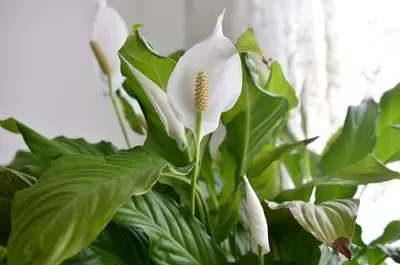
It’s no wonder the peace lily (Spathiphyllum wallisii) is one of the most popular houseplants available today. With its glossy dark green leaves and dramatic hooded white flowers, it makes a fabulous focal point in any room. This visitor from the tropical rainforests of South America has been brightening up our homes since the 1870s, thanks to its good looks and easy-going nature. Here’s how to keep your peace lily looking its best.
Where to grow a peace lily
Being rainforest plants, peace lilies like a warm, humid and semi-shaded environment. Place your peace lily out of direct sunlight and stand the pot on a water-filled saucer of pebbles to increase the humidity level around the plant. Peace lilies are good at letting you know when they need watering, as they’ll start to wilt. Ideally, you should water regularly enough to prevent them wilting, but if you do occasionally forget, don’t worry – peace lilies revive amazingly well. Feed once a month from spring to autumn with a balanced liquid houseplant feed, and wipe the leaves with a damp cloth to remove dust.
Always keep peace lilies away from pets, as the plants contain oxalates which are toxic to both cats and dogs.
Getting a peace lily to flower
Peace lilies flower best in bright but indirect light, and usually flower in spring, producing one or two white hooded blooms that can last for over a month. They may occasionally flower again in autumn. Once the flowers have faded, deadhead them to keep the plant looking neat.
Repotting a peace lily
If your peace lily’s roots are starting to grow out of the pot’s drainage holes, it’s time to repot it into a slightly larger container. Here’s how it’s done:
- Water your peace lily the day before you repot it.
- Fill the new container one-third full with multipurpose potting compost.
- Remove the plant from its old container and tease the roots loose if necessary.
- Place it in the new container, fill around the roots with compost and press down gently. Top up the box with compost to about 1cm (0.5in) below its rim.
- Water well and allow to drain through, then place the new container on its drip tray.
Common problems with peace lilies
Browning leaf tips is a common problem, and this could be the result of overwatering, overfeeding, or a lack of humidity. Change one condition at a time and observe the effect on your plant. Yellowing leaves means that the plant is getting too much sunlight and needs to be moved out of direct light. Peace lilies are usually free from most pests and diseases, and regular wiping of the leaves will get rid of the occasional aphid or other pests.
Peace lilies and other houseplants help make our homes into calm and tranquil spaces. Contact us to find out more about our range of houseplants and other gardening products.
